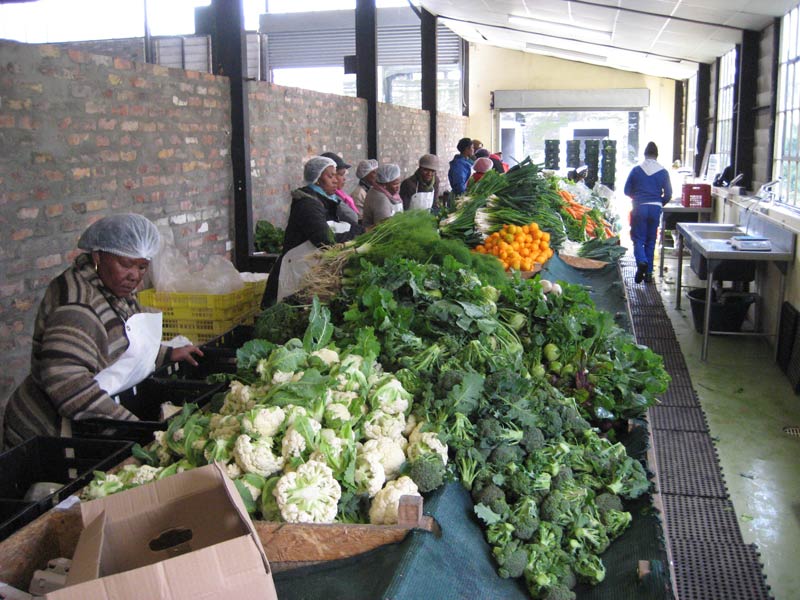Community food gardens can provide an important tool for household sustainability in South Africa, where less than half the population is food secure and 12 million people go hungry every day.
“I now have food to put on the table every day of the week,” says Sibongile Sityebi from Cape Town’s Gugulethu township. “I did not have that before. I was unemployed and did not have money to buy healthy food.”
For the past five years, Sityebi has worked at the Asande Food Garden in Gugulethu, an initiative of non-profit organisation Abalimi Bezekhaya. Meaning “Farmers of Home”, this Cape Town-based organisation encourages local township residents to grow their own vegetables. The objective is for these farmers to feed themselves, their families and the community.

Food insecurity remains a widespread problem across Cape Town and the rest of South Africa. According to a study by the African Food Security Unit Network at the University of Cape Town (UCT), 12 million South Africans – almost 25% of the population – go hungry on a daily basis. This figure excludes individuals who are at risk of being hungry, which is another 25%. Food security has declined over the past five years, with only 45.4% of South Africans categorised as “food secure” in 2012, compared to 48% in 2008, according to the Human Science Research Council and the Medical Research Council.
Sityebi, who is now leading Asande and managing three other farmers, says community vegetable gardens can bring much-needed relief.
“The gardens of Abalimi make food insecurity in our areas a bit better,” the farmer says. “People here don’t have enough money for healthy food. We at Asande for instance donate part of our produce to soup kitchens and give it away to people who have nothing.”
It is difficult to determine exactly how many South Africans benefit from food gardens, as comprehensive figures are not available. A quick Google search however shows that there are many hundreds of community vegetable initiatives scattered across the country, from Cape Town to Johannesburg, from Bloemfontein to Durban.
Abalimi’s impact is easier to calculate, with 200 food gardens. Each of these are tended by five micro-farmers each supporting between five and seven people – the size of an average household. This means that a minimum of 10 000 people directly benefit from Abalimi gardens, excluding thousands of residents in neighbouring areas who are now able to access affordable and healthy food.
“Twenty-five percent to 50% of Abalimi’s output is consumed locally, by the farmers and their dependents as well as their fellow community members,” says Abalimi co-founder Rob Small, adding that the gardens grow a wide variety of seasonal crops. “These are people whom are most affected by food insecurity. The rest is sold to more affluent consumers as well as some retailers. This is what keeps our operations going.”
The gardens’ impact on farmers’ health has been significant. “The universal response of our farmers is is that they felt desperate and unhealthy when they started and healthy and empowered after being with us for a few months,” Small says. “Our farmers love the food they are eating and the fact they are working outside. People are less sick, and have fewer doctors’ bills. They feel psychologically better and more dignified. Community vegetable gardens, in other words, definitely have a positive impact on food security – and on overall well-being.”
University of the Western Cape graduate Marc Lewis agrees. Last year he did extensive research on the positive impact of urban vegetable gardens and food security in Johannesburg for his master’s degree at the university.
“When initiated and run properly, vegetable gardens can improve food security at household and community level,” he says, adding that the gardens he looked at alleviated food insecurity in two ways: by providing food for the farmers and by selling produce straight to the community at much lower prices than produce available in the shops. “This is where healthy affordable food is needed the most.”
Support from other stakeholders, such as the government, municipalities, corporates and non-governmental organisations, can be a critical success factor for gardens, particularly for access to land and water. International NGO, ONE.org recently launched a new pan-African campaign known as Do Agric, It Pays, calling for more and better investment in agriculture by African governments. ONE.org’s executive director for Africa, Dr Sipho S. Moyo states that better structured support for small holder farmers and their needs, such as irrigation and access to land, is essential not only in combating poverty, but also in assuring sustainable economic development. Such investments could help further transform South Africa’s community gardens and multiply the gains.
“In 2003, African leaders pledged to invest 10% of their national budgets in agriculture – only eight of them have kept that promise. Do Agric, It Pays calls on governments to not only meet this promise, but to implement policies that are targeted towards protecting and promoting small holder farmers, leveling he field for women, and developing the value chain, among others. The private sector cannot do it alone. In countries such as Burkina Faso and Ethiopia, the government has come to the aid of the private sector with targeted investments in agriculture, and the results hav been significant in terms of poverty alleviation, job creation and overall economic development.”
“Some of the gardens I studied had free water access,” Lewis says, adding that good management of gardens and resources is important. He stresses that someone needs to take control to prevent initiatives to become fragmented.
“Lastly, community gardens should be informal market, and not formal market, orientated,” he says. “It is in the communities in which these farms operate where good and healthy food is needed the most. The market is solid.”
Miriam Mannak for ONE.org
